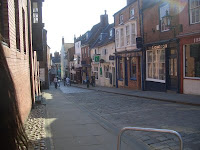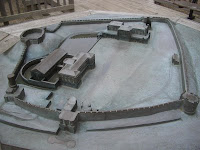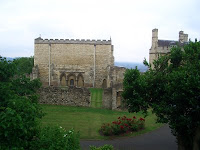So, this Friday morning we got off the bus by the market square where we wandered around the stalls, to the musical accompaniment of a country & western singer (who actually was quite good), and Honeybuns bought herself an interesting cheese. We ascended Steep Hill, which, in addition to other interesting shops, contained a goodly number of used book shops, which obviously all had to be visited. As we were going to do some walking that day, we couldn't obviously buy all worthy books, but some sufficiently light-weight items found our favour.
Eventually we were at the summit of the hill. Not by coincidence, this is where the Tourist Information Centre is (there is another one down at the city centre, but it is currently closed for renovation), so I might as well stick in a bit of tourist information here:
The general area of Lincoln has been inhabited for a long time, but the name and the first stone buildings date from the Romans. There are still a few remains, such as bits of the old city wall, left from Roman times. The next high period for the town came with the Normans, who started on the castle and the cathedral, both of which were greatly expanded in mediæval times; there are also a few Tudor era houses left. The first World War I tanks were constructed in Lincoln and during World War II Lincolnshire was “Bomber county”. All these various historial eras are carefully commemorated with signs, museums and the items themselves, of course, and there are a number of marked theme trails around town, so show off Roman, Norman, etc remains. Even though the town is so obviously prepared for tourists, there didn't seem to be particularly many around, which I provisionally put down to the English school term not being over yet. Swedish tourists were clearly not common here, I suspect they only leave Regent Street to go see Mamma Mia!.
 Honeybuns descending into the interior of Cobb Hall Tower. Lots of dark nooks and crannies down there.
Honeybuns descending into the interior of Cobb Hall Tower. Lots of dark nooks and crannies down there.Finally hunger drove us out and we found a little vegetarian restaurant on Steep Hill, where some rather surly teenagers served us a quite good lunch.
Then we walked a circuit around the cathedral, but decided to see the mediæval Bishop's palace instead. It is mostly a ruin these days, but an audio presentation did its best to bring its old splendour alive to us. I actually enjoyed this audio tour better than the one at the recent Titanic exhibition as this one only played fairly short clips and then waited for the user to start the next clip, thus allowing much better self-pacing.
The museum closed, so we had to leave, and decided to set out to find the mysterious tower we had seen. Oh, it was a water tower. Apparently it didn't qualify for marking on any maps, just being public works, as it were. We found a pub for dinner and then descended the hill for the bus home.







4 comments:
Fascinating onomastic etymology. Grazie.
Oh, sorry -- I enjoyed the whole post, not just the implicit Lincoln < Lindum Colonia.
Lincoln has an interesting topology
A topologist is a person who can't tell a coffee cup from a donut.
Which is why people bleeding from their mouths are constantly being lead out from the Math department.
Post a Comment